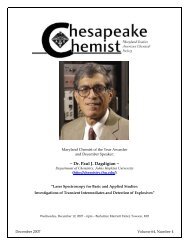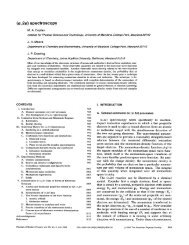Graduate Study in - Chemistry - Johns Hopkins University
Graduate Study in - Chemistry - Johns Hopkins University
Graduate Study in - Chemistry - Johns Hopkins University
Create successful ePaper yourself
Turn your PDF publications into a flip-book with our unique Google optimized e-Paper software.
Marc M. Greenberg<br />
Organic and Bioorganic <strong>Chemistry</strong><br />
mgreenberg@jhu.edu<br />
Ph.D., Yale <strong>University</strong><br />
American Cancer Society<br />
Postdoctoral Fellow,<br />
California Institute of<br />
Technology<br />
Alfred P. Sloan Research<br />
Fellowship<br />
As the carrier of genetic <strong>in</strong>formation, it is no surprise that DNA damage and<br />
repair is important <strong>in</strong> ag<strong>in</strong>g and a variety of genetically based diseases, such<br />
as cancer. However, modified nucleic acids are becom<strong>in</strong>g <strong>in</strong>creas<strong>in</strong>gly<br />
important as diagnostic tools and therapeutic agents. The pivotal roles of<br />
DNA <strong>in</strong> chemistry and biology are <strong>in</strong>terwoven. For <strong>in</strong>stance, the reactivity of<br />
DNA with reactive oxygen species determ<strong>in</strong>es the types of structural modifications<br />
(lesions) formed. The <strong>in</strong>teraction of lesions with repair and polymerase enzymes <strong>in</strong><br />
turn determ<strong>in</strong>es their biological effects. Identify<strong>in</strong>g the location and level of DNA<br />
lesions <strong>in</strong> the genome may assist the diagnosis and treatment approach of disease.<br />
Our research group uses organic chemistry to address questions concern<strong>in</strong>g<br />
the reactivity, function, structure, and uses of nucleic acids. Examples of current<br />
projects <strong>in</strong> our group are:<br />
• determ<strong>in</strong><strong>in</strong>g how nucleic acids are oxidatively damaged by synthesiz<strong>in</strong>g molecules<br />
(e.g 1) that enable us to <strong>in</strong>dependently generate reactive <strong>in</strong>termediates at def<strong>in</strong>ed<br />
sites <strong>in</strong> DNA.<br />
• elucidat<strong>in</strong>g the effects of specific DNA lesions (e.g. 2, 3) on the function of nucleic<br />
acids, and their structural basis.<br />
• the development of methods and applications for modified oligonucleotide<br />
synthesis.<br />
To br<strong>in</strong>g these projects to fruition we synthesize novel molecules and study<br />
their behavior us<strong>in</strong>g a variety of physicochemical, biochemical, and biological<br />
techniques. Recent accomplishments by our research group <strong>in</strong> these areas <strong>in</strong>clude:<br />
• the discovery of novel pathways for DNA damage that produce tandem lesions<br />
(Scheme 1).<br />
• the discovery of the first example of irreversible <strong>in</strong>hibition of DNA repair by a DNA<br />
lesion (Scheme 2).<br />
• the first synthesis of oligonucleotides conta<strong>in</strong><strong>in</strong>g formamidopyrimid<strong>in</strong>e lesions (e.g.<br />
Fapy•dG) and determ<strong>in</strong>ation of their effects on DNA repair and polymerase<br />
enzymes.<br />
• the development of highly efficient, convergent methods for oligonucleotide<br />
conjugate synthesis.<br />
In addition to cont<strong>in</strong>u<strong>in</strong>g these research projects, the above discoveries have<br />
given rise to new projects <strong>in</strong> our group that <strong>in</strong>clude the development of novel<br />
radiosensitiz<strong>in</strong>g agents and mechanism based <strong>in</strong>hibitors of DNA repair enzymes.<br />
Selected publications <strong>in</strong>clude:<br />
Fapy•dA Induces Nucleotide Mis<strong>in</strong>corporation Translesionally by a DNA Polymerase. Delaney, M. O.; Wiederholt, C. J.; Greenberg,<br />
M. M. Angew. Chem. Int. Ed. 2002, 41, 771.<br />
Oxygen Dependent DNA Damage Amplification Involv<strong>in</strong>g 5,6-Dihydrothymid<strong>in</strong>-5-yl <strong>in</strong> a Structurally M<strong>in</strong>imal System. Tallman, K.<br />
A.; Greenberg, M. M. J. Am. Chem. Soc. 2001, 123, 5181.<br />
(3)<br />
The 2-Deoxyribonolactone Lesion Produced <strong>in</strong> DNA by Neocarz<strong>in</strong>ostat<strong>in</strong> and Other DNA Damag<strong>in</strong>g Agents Forms Cross-L<strong>in</strong>ks with<br />
the Base-Excision Repair Enzyme Endonuclease III. Hashimoto, M.; Greenberg, M. M.; Kow, Y. W.; Hwang, J.-T.; Cunn<strong>in</strong>gham, R. P.<br />
J. Am. Chem. Soc. 2001, 123, 3161.<br />
Introduc<strong>in</strong>g Structural Diversity <strong>in</strong> Oligonucleotides Via Photolabile, Convertible C5-Substituted Nucleotides. Kahl, J. D.; Greenberg,<br />
M. M. J. Am. Chem. Soc. 1999, 121, 597.<br />
Scheme 1 Scheme 2<br />
1<br />
2<br />
12<br />
<strong>Graduate</strong> <strong>Study</strong> <strong>in</strong><br />
<strong>Chemistry</strong> at The <strong>Johns</strong> Hopk<strong>in</strong>s <strong>University</strong>







